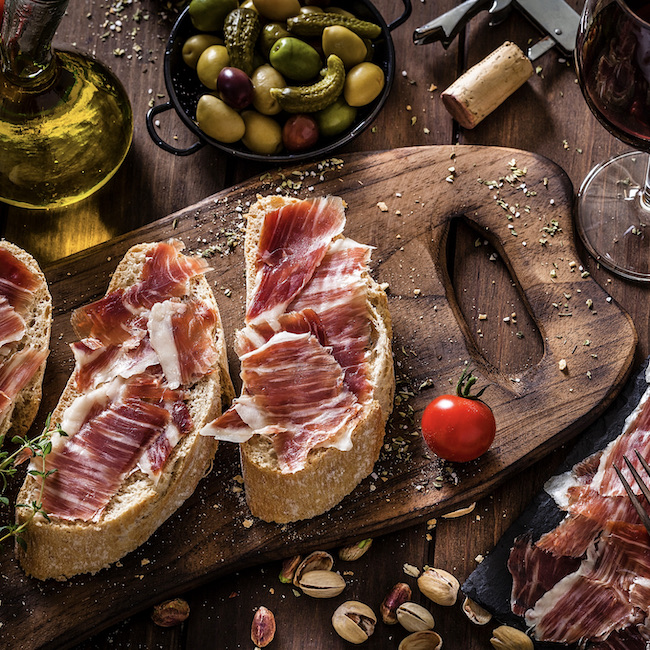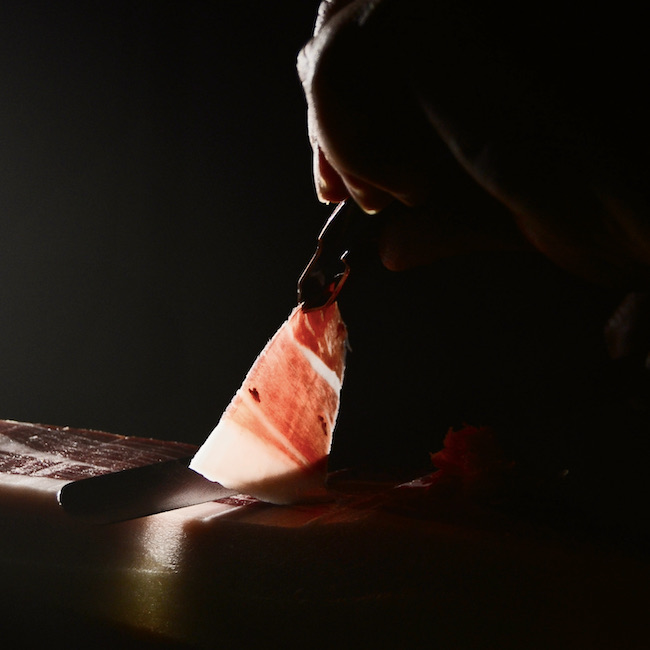.png.transform/rendition-xs/image_image%20(1).png)
An Expert’s Guide To Pata Negra
Pata Negra, the Iberian cured ham of Spain, is classified to ensure you know what you are getting. Expert Fernando Maíllo Ferrán helps us to understand this quality seal!
If you want to understand Pata Negra - the Iberian cured ham of Spain - it’s important to know about legislation passed in 2014 that was designed to enable classification and labeling of the different types of Jamón Ibérico, ultimately to make it easier for the consumer to navigate. This type of labeling is the key to information about provenance and animal rearing. It lets us know whether the Jamón Ibérico pig has been farmed in Dehesa pastureland, its diet - be it acorn or otherwise - the animal’s family tree and the curing process. And there are also anatomical differences between Ibérico pigs and the common pig. So, to help us understand the terms Pata Negra and Jamón Ibérico fully, let’s ask expert Fernando Maíllo Ferrán, International Director for the Monte Nevado Group. His is a family business boasting over 155 years producing award-winning Jamón Ibérico and it recently launched Ham Campus - a training and research facility North of Madrid that’s all about Jamón Ibérico!

The term Pata Negra - does this refer exclusively to the Iberian pig, or are there other black-footed species of the animal?
The term Pata Negra is now regulated. It was decided to use it only for 100% Jamón Ibérico de Bellota - the acorn-fed Iberian pig. Previously there was confusion as there are other types of pigs that may also have black hooves, like Duroc for example. There are also different types of Ibérico pig (some may have patchy colored hooves), so the farmers started selecting the males and females with the black hooves, to be able to produce 100% Pata Negra.
What are the different quality levels and labeling that apply to Jamón Ibérico and its products?
The highest categorisation is black label Jamón Ibérico, which ensures that the pig is 100% free range and acorn fed in its final months, and that it also eats grass (which it needs). The next category is red label Jamón Ibérico. The pigs parents do not necessarily have to be 100% Ibérico breed - the sow must be Ibérico while the sire could be a cross breed or a Duroc breed. The pig is acorn fed in its final months. Then there is the green label, known as cerdo Ibérico de campo. These animals must be a minimum 50% Ibérico breed and have been farmed free range, although they can be grain fed. In Monte Nevado, the green label animals are raised in the same range areas as their Jamón Ibérico de Bellota black label brothers, but their feed comes from different sources. Because pigs are only farmed twice a year, the black label pigs can graze when the acorns fall, from November to February. But the green label pigs that feed later, don't eat acorns because there aren't any left! These are the cerdos de campo. The last label is the white label Jamón Ibérico. The pigs are 50% Ibérico breed, raised on farms and fed fodder.
How do we distinguish a pata negra product from one that is not jamón Ibérico?
Firstly, by the labeling because the controls are strict and they offer a guarantee. Then there are visual cues. With the Pata Negra breed, to be able to cure it slowly we need a lot of fat on the animal so that we can get more flavor over time. The diffusion of the fat in the resulting Jamón Ibérico makes it a more fragile texture, which looks marbled. Another visual difference is the length of the leg - Jamon Iberico are longer with a finer ankle, thanks partly to their exercise in a free range environment.

What makes pata negra a sustainable product?
There is nothing more sustainable than the production of Jamon Iberico in Monte Nevado. It is a traditional system that remains exclusive to Spain. The Dehesa acorn pasturelands are DOP protected regions and they are the only places that are ideal for this production - it’s a balance between flora and fauna, which is very sustainable. Even the cerdos Ibéricos that are farmed in different parts of Spain are also considered sustainable because they are raised on small, family-owned farms with a lot of rural surface area and farmland, so they are not producing a negative impact on the environment. The animals are treated well, in part because this sector aimed not to become industrialized.
Which parameters are used for quality control in pata negra products?
We work with different farmers, making sure they feed the animals acorns for approximately three or four months, fattening them to nearly 400 pounds in weight. As for the Cerdo Ibérico del Campo - the white label - we also like to choose animals that have aged to 10 months so they are adults. This makes for a better quality product than when the animal is younger. The certified labeling is a good guarantee, as there are a lot of inspections to make sure that the producers are complying with standards. We always work with the same producers to maintain the same quality assurance. What’s more, the Ham Campus allows us to make a lot of analyses and controls. Just by smelling the ham when it cures you know if the pigs have been properly fed because, in the end, everything that has been consumed by the pig comes out in the final product.
And finally, what would you pair with a platter of your best pata negra Jamón Ibérico?
It goes well with a glass of good manzanilla from the DOP Jerez-Xérès-Sherry!

